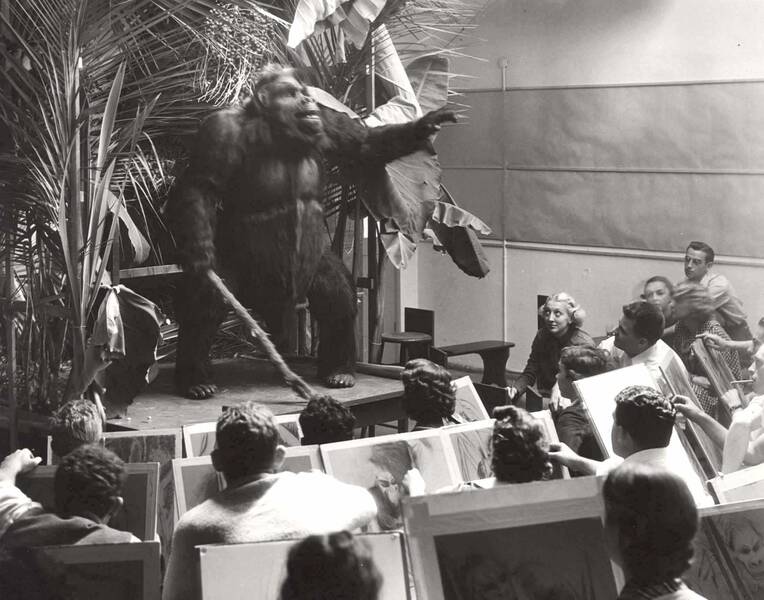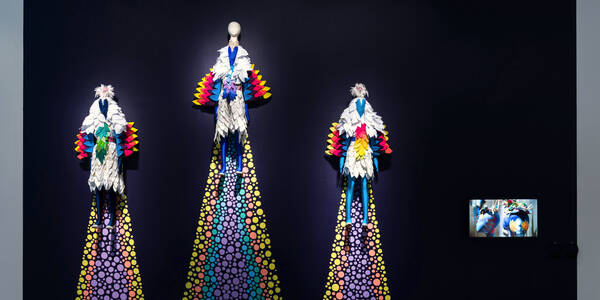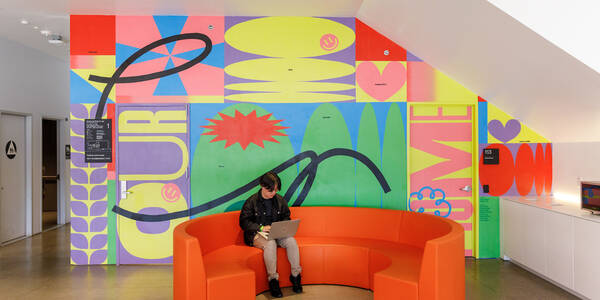
feature / college-news / staff / faculty / diversity
October 27, 2022
By Solvej Schou
EVERYONE IS WELCOME HERE
ARTCENTER LIBRARY IS A SAFE SPACE OF LEARNING FOR ALL
When Mario Ascencio, ArtCenter Library’s college librarian and managing director, was a teenager working at his local public library in southeast Los Angeles, one day a woman came in, speaking to him in Spanish and looking for films. She was ashamed to say that she was illiterate.
“Being able to help this woman fill out a library card application and give her a key to the city’s resources, I thought, ‘I want to do this for the rest of my life,’” says Ascencio. “Back then, as a young gay Latino, I could find books about being gay at my library. Libraries are the cornerstone of democracy, where people of different backgrounds can go in and get information.”
A hub of openness and knowledge at the College, ArtCenter Library is “a safe space for all,” says Ascencio. It includes the flagship Hillside Campus location Fogg Library, named and dedicated in 1978 in the memory of Advertising alumnus James Lemont Fogg (BS 72); an upcoming South Campus location in the 1111 building; and Archives and Special Collections and its new spacious research space, the Jules Bates Artrouble Center, in the 950 building on South Campus.

We’re focused on helping students be lifelong learners, and I love seeing them use our collection for their work, even just for inspiration.
Mario AscencioArtCenter Library's College Librarian and Managing Director

Since Ascencio joined ArtCenter in 2014, the Library has launched an interlibrary loan program and decided to get rid of overdue fines. Each academic department at the College has an assigned liaison librarian to help students work on projects, says Ascencio. Librarians can be contacted in person or can chat live online—a Library website feature that launched during the COVID-19 pandemic. An already existing book pickup service also gained in popularity during the pandemic, and is available at both Hillside and South Campus.
“We’re a private institution, but we allow everyone in the community, and external researchers, to use our collection and online resources while on campus,” says Ascencio, who has a bachelor’s degree in art history and a master’s degree in library and information science, and serves as chair of the Board of Directors for the Statewide California Electronic Library Consortium (SCELC)—its first Latinx board chair. “Information needs to be preserved so that people 500 years from now can learn about art and design,” he adds.
Filled with aisles of books and long tables for quiet study, the flagship Fogg space also includes a communal collaborative multimedia area in the works, with mobile furniture that can be rearranged by students, says Ascencio. A multicolored flag inside the entrance—hung in June for LGBTQ Pride Month—proclaims “Everyone Is Welcome Here.”
Events at Fogg have ranged from a regularly held Zine Party, to create original zines, to a recent Block Party, co-hosted by the Library, with throngs of students and faculty—including Entertainment Design Assistant Professor Fernando Olmedo (BS 14) and his Art of Research course students—mingling and talking to liaison librarians.


“The Library is the heart of ArtCenter,” says Jennifer Faist, director of the Library’s Collections and Systems. “Not only physically—with Fogg Library being in the middle of Hillside Campus, with windows that allow people to view in and out—but also as a provider of a service.”
Also a visual artist who has two degrees in painting, Faist has worked at the Library for more than 26 years, and has seen the services it provides change with the times. The Library experience has transformed from a centralized and largely analog one into a robust set of digital offerings. The emphasis on diversity is also a priority, Faist says.
“We try to do a lot of collection development and virtual talks with artists and creators that are in underrepresented populations: Black, LGBTQ, Latinx, Asian American communities and more,” says Faist. “The Library is a very interdisciplinary space, and faculty and students from every major come here to collaborate, cross-pollinate and make connections.”
Academic and research libraries are essential to a thriving global community of learners and scholars, adds Erin L. Ellis, president of the Association of College and Research Libraries (ACRL), a division of the American Library Association (ALA). They navigate shifting modes of teaching and learning, lead and support the work of equity and social justice, and advance efforts to broaden perspectives, she says.
“Libraries have continually transformed in response to new and emerging campus needs, and play a critical role in providing spaces and services that are inclusive and welcoming,” says Ellis. “Academic and research libraries continue to be flexible, innovative and responsive, and are vital to the success of our diverse campus communities."


As a repository for records that document both the College’s history and the history of art and design—reflecting a diverse variety of artists and designers from around the world—the Library’s Archives and Special Collections includes 125 collections, 2,200 books, more than 100,000 photographs and 3,000 videos and films, and a Virtual Archives online catalog.
The Archives’ Jules Bates Artrouble Center—with its compact shelving and a large area with tables for students, faculty, staff, alumni and researchers—opened in 2021, thanks to a gift from ArtCenter Trustee Melissa Lora and her husband Michael Lora, in memory of her brother, Photography and Imaging alumnus Jules Bates (BFA 78). On the walls hang framed photos of musicians by Bates, a Los Angeles photographer who co-founded the art collective Artrouble, created album covers for bands like Oingo Boingo and documented the L.A. punk scene.
In late 2020, the Library’s Archives and the College’s Interaction Design Department launched Reimagining Access: Inclusive Technology Design for Archives and Special Collections, a project that aims to improve the experience of people with disabilities using digital archives and special collections. The project’s human-centered approach to technology earned it a National Leadership Grant—the largest competitive federal grant in the College’s history—from the Institute of Museum and Library Services (IMLS).
“It’s essential that we determine the most effective ways to make materials accessible, so that students can learn from primary source materials and first-hand accounts,” says Archives and Special Collections Director Robert Dirig. “Sharing knowledge with students, faculty, staff and researchers, and them discovering something new, is truly the icing on the cake.”
The Library also frequently collaborates with other College departments, including the Center for Diversity, Equity and Inclusion (DEI), Career and Professional Development (CPD), the Center for Teaching and Learning (CITL), ArtCenter Exhibitions, ArtCenter Extension (ACX), and the interdisciplinary Humanities and Sciences Department.
All ArtCenter students take Humanities and Sciences courses, and faculty rely on the Library as a support system for students, says H&S Chair Jane McFadden. The department works closely with Library staff to build collections around shared interests.
“It’s where students can take their curiosity in the classroom into a larger realm, making connections to their own practice and beyond,” says McFadden. “They seek out the Library for refuge, community and creativity in whatever form that may take in our multifaceted pandemic world.”












